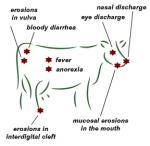Symptoms
 |
| BVD symptoms |
 |
| Severe hemorrhagic syndrome |
SHS: Severe BVD infection, often caused by a virulent ncp BVDV of genotype 2. Destruction of blood platelets (thrombocytes) leads to a coagulopathy (e.g. bleeding from eyes and nose). Other possible symptoms are fever, bloody diarrhoea and inappetence. (courtesy of J. Brownlie)
BVD has many faces. The course of infection depends on the state of the affected animal (immunity, gestation) as well as on the virus strain causing the infection. In a naive animal, BVD will cause an acute infection. Depending on the pathogenetic properties of the virus, it will be mild or severe.
Table: Courses of disease
| Course of disease | Description |
| Asymptomatic infections | 70 - 90% of BVD infections are asymptomatic or mild. The livestock holder usually does not take notice. |
| Classic, acute Viral diarrhoea (most animals recover) | The classic, acute BVD form brings about symptoms like diarrhoea (may contain blood or mucus), fever, anorexia, nasal and eye discharge and erosions in the oral cavity, on the muzzle, on the vaginal mucosa as well as in the interdigital cleft. Hardly ever do all symptoms occur at the same time in an animal. Approx. 4 - 7/8 days post infection, the virus can be detected in most body fluids [82][83]. BVD has an immunosuppressive effect (the slow rise of the antibody titer over a period of three months [84] seems to reflect this) which brings forward secondary infections. Acutely infected bulls may suffer a transient decrease in sperm quality (apart from that, acutely infected bulls shed the virus with their sperm). |
| Peracute Viral diarrhoea (often fatal) | Severe forms of BVD with thrombocytopenia and leukopenia have been described in the USA and Canada. Most cases have been associated with virus of genotype II. Similar cases occurred in Switzerland, but genotype II has never been involved so far. |
| Pneumoenteritis-Complex | BVDV is supposed to play a major role in the pneumoenteritis-complex in fattening calves. As is generally known, quite a number of viruses, mycoplasmas and bacteria participate in this hard to cure syndrome. Infections with multiple viruses in the same animal are not rare. |